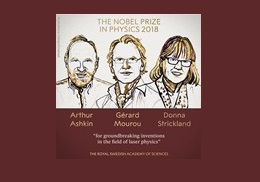
Arthur Ashkin (New York, 1922), has won half of this year's Nobel Prize in Physics, at the age of 96, for the invention of the 'optical clamps or traps'. The 'clamps made of light' were obtained for the first time by Ashkin at the Bell Laboratories in the seventies. This discovery allowed the researchers to move small particles at their will, by using the laser light. The application of this discovery to biomedicine is relevant because it permits the observation of the evolution of biological systems such as bacteria or viruses.
Donna Strickland (Guelph, Canada, 1959) shares the other half of the Prize with her thesis advisor, Gérard Mourou (Albertville, France, 1944). The work for which they have been granted was developed while Strickland was a PhD student. They invented together the high intensity ultra-short laser pulses, producing the shortest and more intense pulses ever generated. This technique is used to observed instantaneous processes, like the motion of electrons in atoms or eye surgery. Before their discovery, the intensity of the pulses was limited by their own high power, which destroyed the amplifier used to produce them. Strickland and Mourou had the idea to use a net to extend the pulse before being amplified by conventional amplifiers. After amplification, the pulse is immediately compressed, producing a high-power, short pulse. This process is known as Chirped Pulse Amplification.
The ultra-fast pulses are of the order of femtoseconds, this is, 10-15 seconds, or, in other words, one million-billionth of a second. This process can be understood as a video camera that took more and more pictures per second, up to the point that it allowed us to visualize fast evolving events such as the photosynthesis. Furthermore, because of their short duration, they are less harmful for the observed object, and this is the reason why they are not only used in eye surgery, but also as efficient microperforators.
Scientific prizes, and obviously the Nobel Prize, are a public reconnaissance of the excellence and provide enormous visibility. It is notorious that the female scientists work has not been properly recognised by those prizes. In particular, up to this year, only Marie Sklodowska Curie in 1903 and Maria Goeppert-Mayer in 1963 had won the Physics Nobel Prize, while 210 men had. Donna Strickland is thus the third woman to win this Prize in our branch of Science. Physics has the lowest percentage of female winners among all sciences, with a 1%. Therefore, Strickland's prize is an excellent news because it will help to show the female work on Physics. Moreover, the work for which the Royal Swedish Academy of Science has granted her, together with Gerad Mourou and Arthur Ashkin, is crucial to understand the importance of Optics during the last decades.











